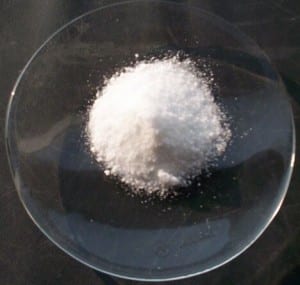Materials:
- Lab apron

- Eye protection
- Centigram or analytical balance
- 8-10g or unknown salt
- Water
- Thermometer
- 3 Styrofoam cups (calorimeter)
- 100 mL cylinder
- Filter paper
Procedure:
- Safety equipment, including goggles were put on.
- 8-10g of an unknown salt on a filter paper was obtained from the teacher. The mass of the salt and filter paper were measured on the balance and was recorded.
- The salt was taken to the work station. A calorimeter, thermometer, and a 100 mL cylinder were obtained and brought to the work station.
- One hundred millilitres of water was measured and placed into the calorimeter. The lid was placed on the calorimeter.
- The temperature of the water was then taken with the thermometer and recorded as the initial temperature of the water.
- The unknown salt was poured into the calorimeter filled with water.
- The lid was placed on the calorimeter. The thermometer was placed in the calorimeter for 5 minutes.
- The temperature was recorded as the final temperature.
- The lid was taken off the calorimeter and qualitative observations were recorded.
- The mass of the filter paper was then recorded using the balance in order to later find the mass of the solid.
- The materials were cleaned and the salt was properly disposed down the sink. The filter paper was properly disposed in the garbage.
Data Collection:
The following chart represents the quantitative observations and their measurements that were taken during the lab.
| Type | Quantity |
| m filter paper | 0.80 g |
| m filter paper + salt | 10.13 g |
| m salt | 9.3 g |
| m water | 100 g |
| c water | 4.18 kJ/kg °C |
| t1 | 23.5 °C |
| t2 | 18° C |
| Δ t | -5.5°C |
Analysis:
Mass of Salt
m salt = (m filter paper + salt) – (mass filter paper)
m salt = (10.13 g) – (0.80 g)
m salt = 9.33 g
Change in Temperature
Δt = (t2) – (t1)
Δt = (18°C) – (23.5°C)
Δt = -5.5°C
Conversions
1 mL = 1g
100 mL= 100 g
Enthalpy
ΔHsystem= – surroundings
ΔH = -mcΔt
ΔH = (100g) (4.18 kJ/kg°C) (-5.5°C)
ΔH= 2299 J
Conversions
1000 kJ = 1 J
ΔH in kJ = ΔH in J/1000
ΔH= 2299 J/1000
ΔH in kJ= 2.299
ΔHsol = (ΔH in kJ) / (msalt in g)
ΔHsol= (2.299 kJ) / (9.33 g)
ΔHsol= 0.2464094 kJ/g
ΔHsol= 0.246 kJ/g
After the calculations of the enthalpy were put together, it could be determined that the unknown salt was Potassium Chloride.

